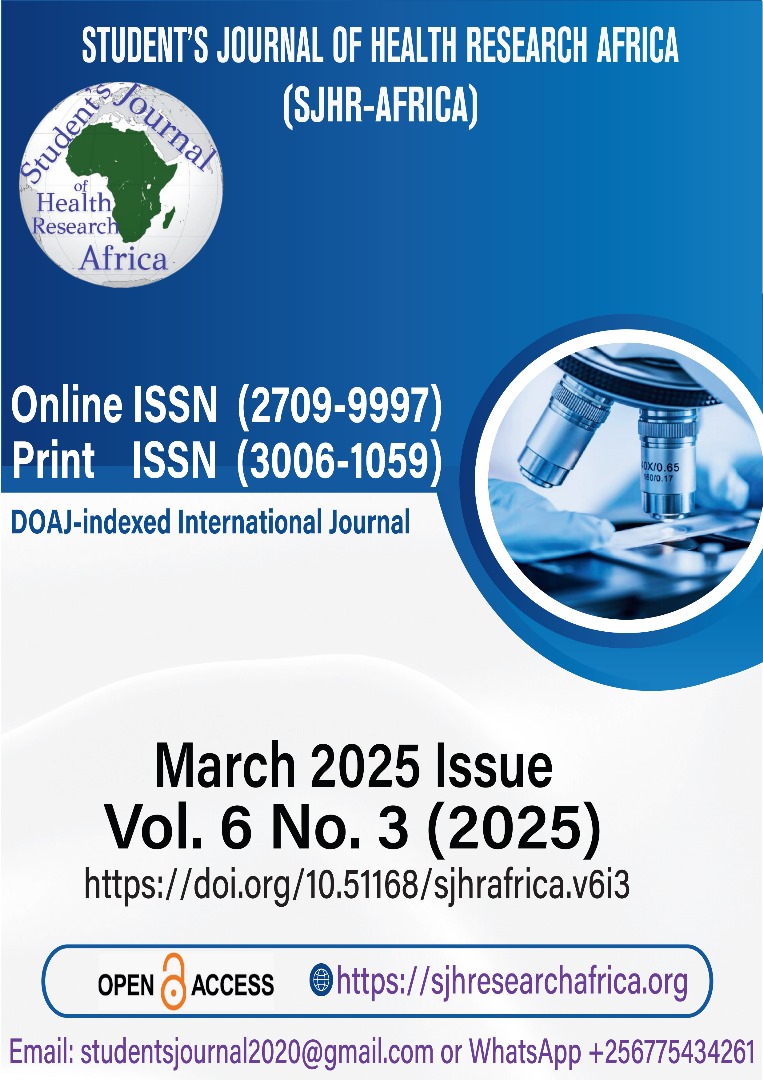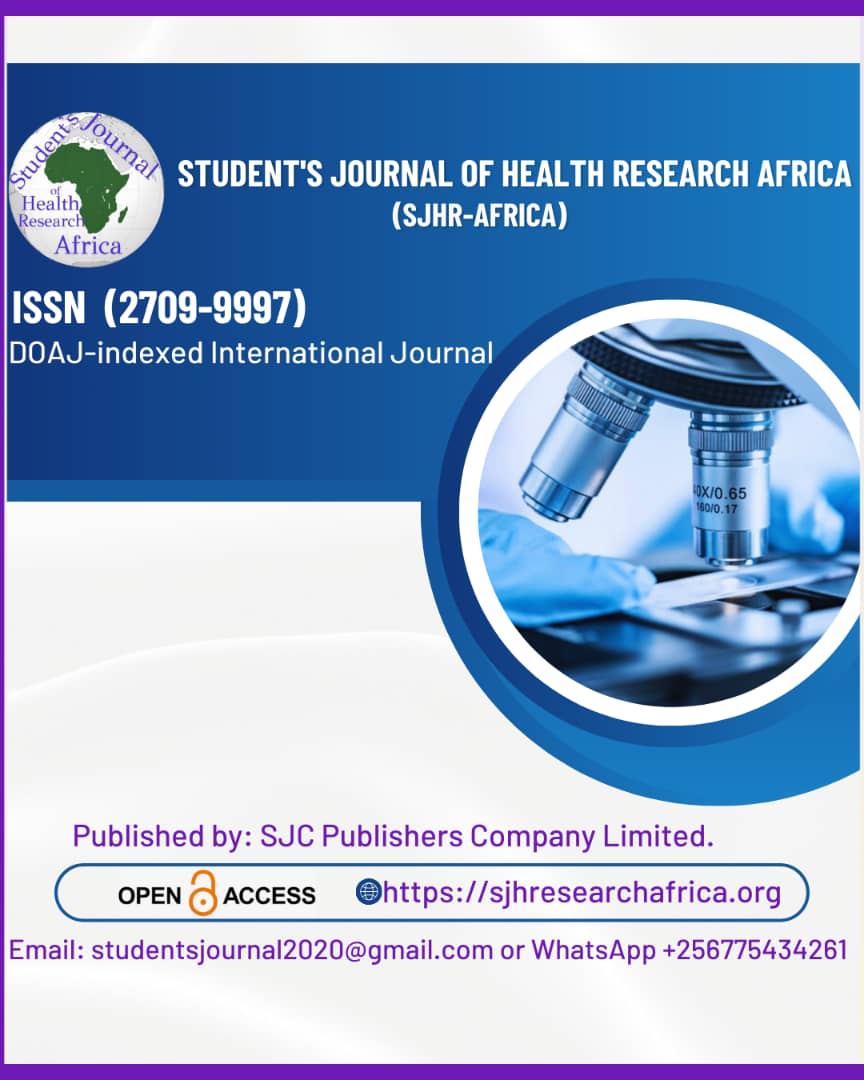KNOWLEDGE, ATTITUDE, AND PRACTICE OF LABOR ANALGESIA IN ANTENATAL WOMEN IN AMALAPURAM: A CROSS-SECTIONAL OBSERVATIONAL STUDY.
DOI:
https://doi.org/10.51168/sjhrafrica.v6i3.1687Keywords:
Labor analgesia, antenatal women, awareness, attitude, pain relief, obstetrics, IndiaAbstract
Background
Labor analgesia is crucial for managing labor pain, yet its awareness and acceptance remain low in many developing regions. This study aims to assess the knowledge, attitude, and practice regarding labor analgesia among antenatal women in Amalapuram, a rural area in India.
Methods
An observational cross-sectional study was conducted with 150 antenatal women aged 18-40 years attending the antenatal clinic at a tertiary care hospital. Data were collected using a structured questionnaire that assessed demographics, knowledge, attitude, and practice regarding labor analgesia. Statistical analysis was performed using Microsoft Excel 2016.
Results
Of the 150 women surveyed, 25% were aware of labor analgesia. The majority (62%) of the 112 unaware respondents expressed interest in learning more, primarily preferring to receive information during obstetric consultations (55%). Concerns regarding labor analgesia were mainly centered around safety (85.3%) and its potential impact on the baby (56%). Regarding attitudes, 76% of participants feared labor analgesia, and 92.6% believed healthcare providers should offer it. Only 30% expressed interest in opting for labor analgesia in future pregnancies, with 70% preferring a natural birth. Knowledge dissemination was largely limited to family and social media sources.
Conclusion
The study reveals a low awareness of labor analgesia among antenatal women in Amalapuram, with significant interest in learning more about it. Healthcare providers, especially obstetricians, should be proactive in educating women during the antenatal period to increase acceptance of pain relief methods, which could improve maternal comfort and birth outcomes.
Recommendations
To improve awareness and acceptance of labor analgesia, healthcare providers, particularly obstetricians, should actively educate antenatal women during early pregnancy visits. Addressing misconceptions, enhancing communication, and providing clear, accurate information about pain relief options can help increase utilization. Further studies should explore cultural factors influencing pain relief choices in diverse populations.
References
Shawahna R, Khaskia D, Ali D, Hodroj H, Jaber M, Maqboul I, Hijaz H. Knowledge, attitudes, and practices of pregnant women regarding epidural analgesia: a multicentre study from a developing country. J Obstet Gynaecol. 2024 Dec;44(1):2354575. doi: 10.1080/01443615.2024.2354575. Epub 2024 May 21. PMID: 38770655.
Leeman L, Fontaine P, King V, Klein MC, Ratcliffe S. The nature and management of labor pain: Part I. Nonpharmacologic pain relief. Am Fam Physician 2003;68:1109-12.
Vincent RD, Chestnut DH. Epidural analgesia during labor. Am Fam Physician 1998;8:1743-6.
Olayemi O, Aimakhu CO, Akinyemi AA. The effect of education on pain perception in labor among parturients at the University College Hospital, Ibadan. Trop J Obstet Gynaecol 2005;22:S15.
Karn S, Yu H, Karna S, Chen L, Qiao D. Women's awareness and attitudes towards labor analgesia influencing practice between developed and developing countries. Adv Reprod Sci 2016;4:46.
https://doi.org/10.4236/arsci.2016.42007
Ponnusamy R, Reddy HK, Murugesan R. Awareness, knowledge and attitude about labour analgesia among providers and parturients; a survey-based study. Anaesth Pain Intensive Care 2018;22:73-80.
Naithani U, Bharwal P, Chauhan SS, Kumar D, Gupta S. Knowledge, attitude and acceptance of antenatal women toward labour analgesia and caesarean section in a medical college hospital in India. J Obstet Anaesth Crit Care 2011;1:13.https://doi.org/10.4103/2249-4472.84250
James JN, Prakash KS, Ponniah M. Awareness and attitudes towards labour pain and labour pain relief of urban women attending a private antenatal clinic in Chennai, India. Indian J Anaesth 2012;56:195-8.
https://doi.org/10.4103/0019-5049.96331 PMid:22701219 PMCid:PMC3371503
Hussain SS, Maheswari P. Barriers for labour analgesia in South India - Knowledge and attitude of relevant stakeholders: A hospital-based cross-sectional study. Indian J Anaesth 2017;61:170-3.
https://doi.org/10.4103/0019-5049.199848 PMid:28250488 PMCid:PMC5330076
Kannan B, Rengasamy CK. Attitude of obstetricians regarding labour analgesia and limitations in practising it. Int J Reprod Contracept Obstet Gynecol 2017;6:388-91. https://doi.org/10.18203/2320-1770.ijrcog20170076
Shidhaye RV, Galande MV, Bangal VB, Joshi SS, Shidhaye UR. Awareness and attitude towards labour analgesia of Indian pregnant women. Anaesth Pain Intensive Care 2012;16:131-6.
Vijapurkar S, Sandeep G, Kalbande JV, Merin Thomas S, Singha SK. Knowledge, Attitude, and Practices of Labor Analgesia Amongst Obstetric Residents: A Cross-Sectional Survey. Cureus. 2024 Jun 13;16(6):e62326. doi: 10.7759/cureus.62326. PMID: 39011223; PMCID: PMC11247256.
Downloads
Published
How to Cite
Issue
Section
License
Copyright (c) 2025 Varada Hasamnis, Mohammed Safiya Shaik, Kagita Vasudha Bhargavi

This work is licensed under a Creative Commons Attribution-NonCommercial-NoDerivatives 4.0 International License.






















